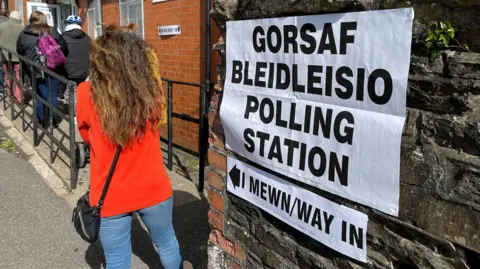What does the Senedd do?
 Getty Images
Getty ImagesVoters in Wales will head to the polls for the next Senedd election on 7 May 2026.
But what exactly is the Senedd, and what does it do?
Here's a brief guide.
First up - what's devolution?
Devolution refers to the transfer of powers from one level of decision-making to a level which is closer to the voter.
In 1997 people in Wales voted narrowly in favour of moving certain responsibilities from Westminster to Cardiff Bay through the establishment of the National Assembly for Wales, which opened in 1999.
Initially, the assembly's powers were fairly limited.
However, over the years further responsibilities have made their way down the M4 including full law-making powers in a number of areas such as health, education, transport, rural affairs, and the environment.
The ability to raise and vary certain taxes has also now been transferred to Cardiff, and the national assembly has been renamed as the Welsh Parliament or Senedd Cymru.
Other areas such as defence, benefits, foreign affairs and major rail infrastructure remain in Westminster.

What's the difference between the Welsh government and the Welsh Parliament?
The Welsh government oversees the running of many public services in Wales, including health, education, and transport.
It also takes decisions with regard to rural affairs, the environment, and local councils.
The government consists of a team of cabinet secretaries and ministers led by the first minister.
Each cabinet secretary is responsible for a different policy area.
The government is usually formed by the party that won the most seats at the previous election.
Up to now, that party has always been Labour.
However, Labour has never managed to win more than half the 60 seats up for grabs and so the party has always had to strike a deal with another party in order to get its policies – and crucially, its budget - through.
Sometimes this has involved members of other parties joining the government to work alongside Welsh Labour ministers.
The Welsh Parliament, or Senedd Cymru, is made up of all the politicians elected to Cardiff Bay.
Its role is to scrutinise the Welsh government's work, including proposed new laws that ministers bring forward.
It is led by the presiding officer, also called the Llywydd, whose job it is to keep order during debates.
Before any new laws are passed, they must be voted through by a majority of Members of the Senedd (MS).
 Getty Images
Getty ImagesWhat's the difference between an MS and an MP?
An MS - Member of the Senedd - sits in Cardiff Bay scrutinising the work of the Welsh government led by the first minister.
An MP - Member of Parliament - sits in the House of Commons in Westminster scrutinising the work of the UK government led by the prime minister.
Wales has 32 MPs.
How much money does the Welsh government spend?
The Welsh government's budget is worth around £26bn for 2025-26.
Most of that money - some £21bn - comes as a grant from the UK government.
The rest comes via taxes that the Welsh government itself raises.
The Welsh government also gets extra money - described as consequential funding - when the UK government decides to spend more money on areas such as health and education in England.
How are things changing in 2026?
 Getty Images
Getty ImagesThe number of MSs will increase at the next election - from 60 to 96.
The way they are elected and the number of constituencies will also change.
The reforms have been controversial.
Supporters say more politicians are needed to reflect the extra responsibilities the Senedd now has compared to when it was set up.
However, critics believe the changes are a waste of money which would be better spent on stretched public services, such as health, social services, and education.
